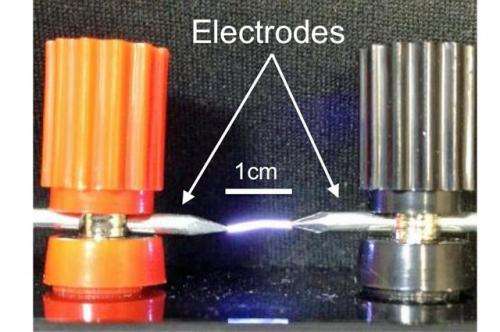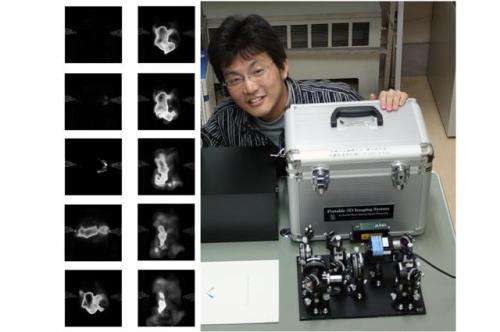3-D digital holography of moving objects at a million frames per second

A million frames per second has been achieved in 3D digital holography of moving objects. The method, developed at Kyoto Institute of Technology in Japan, could be used to analyse high-speed phenomena, including plasmas and the shockwaves produced in explosions.
Capturing light
In holography, three-dimensional information about an object is recorded by recording the wavefronts of light scattered from the object in a hologram, which are traditionally formed on physical media like photographic plates or photorefractive crystal. Holograms are interference patterns formed by interfering laser light scattered by an object (the object beam) with an unscattered (i.e. direct) reference beam from the same source. A 3D image of the object can then be viewed by reconstructing it from the light information recorded. This is done by illuminating the hologram with an appropriate light source.
Electronic image sensors, including CCDs and CMOS devices, have allowed the development of digital holography. In digital holography, an electronic record of the light scattered by the object is made and nu-merical reconstructions of the 3D image of the object are performed by computer, removing the need for physical hologram media and illumination equipment to 'read' the hologram. 3D images at different focal depths can also be calculated from the digital holograms without needing a mechanical focusing system.

Not seeing double
A significant issue in in-line holography is the formation of a 'twin' or virtual image of the objects captured formed with the desired image when a hologram is viewed. This 'twin' image appears in line with the desired image but closer to the viewer, interfering with the view of the desired image. This led to the use of off-axis holography, where the object beam and reference beam are directed at the recording media at different angles. This means that when the hologram is viewed, the 'twin' image is formed at an angle to the desired image and so doesn't get in the way.
However, the larger the angle between the object and reference beams, the finer the interference fringe in the hologram, and the pixel size and spacing of current image sensors are too large to record fine interference fringes. This means that in-line holography needs to be used, fortunately computers also make solutions to the interference problem practical.
One solution developed is phase-shifting digital holography, in which phase-shifting interferometry is used to remove the twin image and other interference sources to acquire a clear reconstructed image. This solution is not suitable for moving objects though, because multiple exposures for recording phase-shifted holograms are needed. The team at Kyoto addressed this problem in earlier work. "Our group proposed parallel phase-shifting digital holography (PPSDH), which can record the multiple holograms required for phase-shifting digital holography with a single-shot exposure. This method can attain both high precision and instantaneous 3D measurement of a moving object," said team member Dr Peng Xia.
Worth a billion words
Building on that work, the team have now demonstrated digital holography at the rate of 1,000,000 frames per second for the first time. In their paper in this issue of Electronics Letters, the Kyoto team demonstrate this frame rate by imaging an electrical discharge arc, but this kind of imaging will have applications in many high-speed phenomena fields, including plasma measurements, the analysis of electrical potential in cells and shockwave analysis.
"One of the most valuable features of this work is that it can measure transparent objects that cannot be recorded by a general digital camera, such as the change of the density of the air around the electrical discharge," commented Xia.
Before the work can be used widely, however, the equipment will need to be miniaturised, and this is the team's current focus. They are confident that this work, combined with current trends in the related technology industries, will allow for a more practical system package soon; Xia predicted that "with the rapid development of industry, a more integrated, miniaturised system of this technique will be achieved over the next decade. This technique will be widely applied in many fields, such as fluid measurements, shock wave measurements and explosion pressure measurements."
More information: "One million fps digital holography." Electronics Letters, Volume 50, Issue 23, 06 November 2014, p. 1693 – 1695 DOI: 10.1049/el.2014.3351
Journal information: Electronics Letters
Provided by Institution of Engineering and Technology
This story is published courtesy of Electronics Letters. For additional Electronics Letters news and features visit theiet.org/eletters.





















